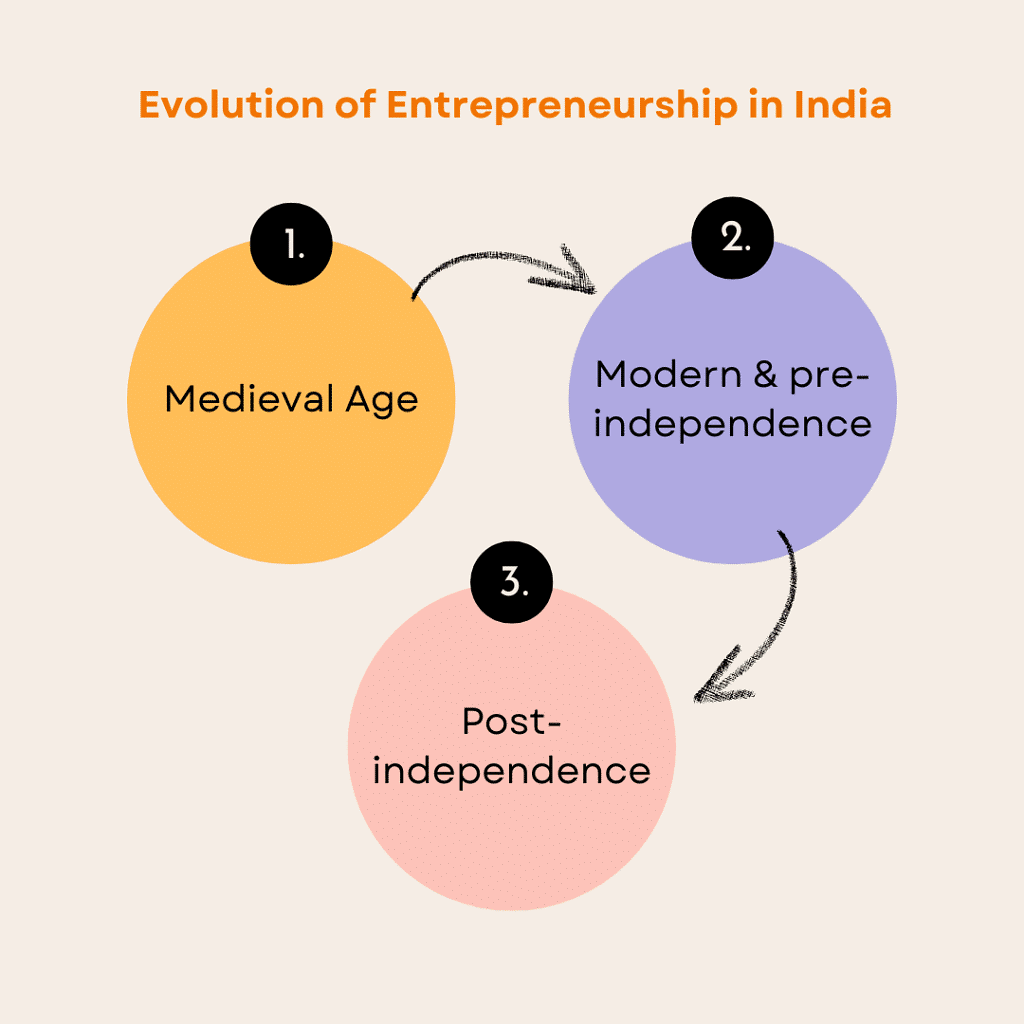Evolution of Entrepreneurship in India | CMAT Mock Test Series - CAT PDF Download
| Table of contents |

|
| Introduction |

|
| Evolution of Entrepreneurship in India |

|
| Industrial Policy of 1948 |

|
| Sources of Entrepreneurship in India |

|
| Ten Entrepreneurs Who Impacted Corporate India |

|
Introduction
Entrepreneurial growth in India traces back to ancient times, as evidenced in the Rigveda period when metal handicrafts were prevalent.
Manufacturing entrepreneurship faced challenges due to inadequate transportation and communication infrastructure. The primary mode of transportation being rivers, artisans in cities like Banaras, Gaya, and Puri engaged in entrepreneurial activities. However, the industry remained small-scale and cottage-based, struggling amidst foreign influences and competition from European industries.
Despite abundant entrepreneurial talent among Indian businessmen, the country failed to provide conducive environments for growth. As a result, many traders sought opportunities in countries like Burma, Singapore, and Kenya. The lack of political support, customs barriers, unfavorable taxation policies, currency complexities, low societal regard for businessmen, and capital shortages hindered entrepreneurial success during that era.
Evolution of Entrepreneurship in India
- Textile Export Trade: In the past, Indian textile exports were thriving despite challenges for entrepreneurs. The entry of European investors transformed trading methods in India. The formation of joint-stock associations among Indian traders to regulate textile supply to Europe was a significant development. Initially, Indian textile goods were highly sought after, leading to a favorable trade balance.

- Challenges Faced: However, entrepreneurs faced obstacles as the British government altered regulations to suppress Indian textile demand. This hindered the growth of Indian entrepreneurs, who relied on merchant class capital and shared profits unequally.
- Commercial Development: Up to 1850, economic progress in India revolved around British private enterprises in sectors like banking, insurance, steamships, and coal mines. Subsequently, British interests expanded to exploit India's natural resources, leading to their territorial penetration.
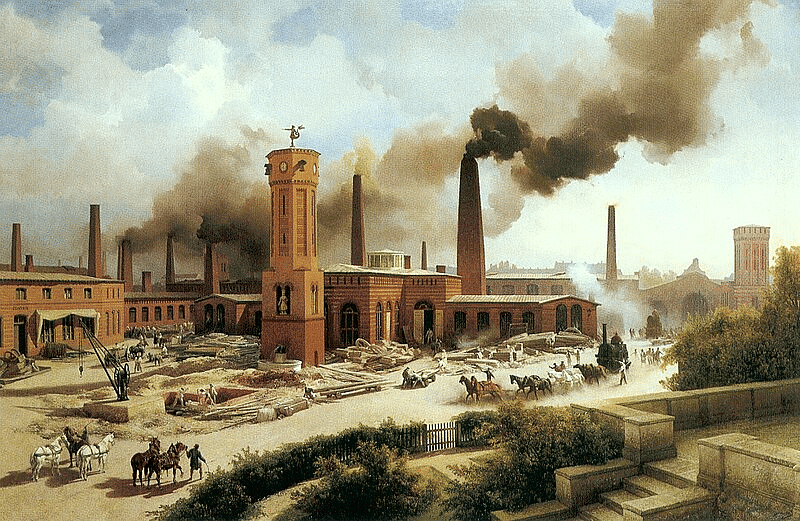
- Manufacturing Entrepreneurship: Post-1850, manufacturing entrepreneurship emerged. The establishment of cotton textile mills in Bombay by C. Davar marked the beginning. Over the years, various entrepreneurs ventured into new industries such as shipbuilding, steelworks, jute mills, and pharmaceuticals.
- Industrial Growth: By the late 19th century, India saw significant industrial growth with the establishment of numerous jute and cotton mills, reflecting the evolving landscape of entrepreneurship in the country.
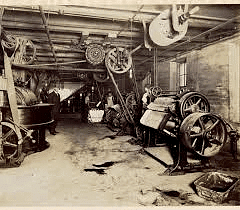
Development of Manufacturing Entrepreneurship in India
- Manufacturing entrepreneurship in India saw significant growth post-1850.
- In 1854, C. Davar established a cotton textile manufacturing unit in Bombay.
- By 1858, there were four textile mills in India, and within 25 years, the number rose to 58.
- Ranchodlal, a Nagar Brahmin, founded a textile manufacturing plant in 1861.

- The East India Company set up the first industry in Surat, attracting numerous entrepreneurs to venture into new initiatives like Jamshedpur steelworks, jute mills, and the pharmaceutical industry.
- By the end of the century, India had 18 jute mills and 51 cotton mills.
Impact of the Swadeshi Movement
- The Swadeshi movement, starting in 1905, focused on promoting indigenous goods and nationalism among Indians.
- Key figures like Ghanshyam Das Birla, Khatans, Goenka, and others played vital roles during this period.
- The movement encouraged Indians to invest in Indian-managed industrial activities, leading to the establishment of businesses like the Swadeshi Mill by Jamshedjee Tata.
- Indian industrialists boycotted foreign goods, which significantly impacted British trade and industries.
- Pioneers such as JRD Tata, MS Oberai, and Jamnalal Bajaj paved the way for Indian entrepreneurs, fostering growth and expansion in various sectors.
Swadeshi Movement in India
The Swadeshi movement, which emerged in 1905, highlighted the significance of supporting Indian goods as a crucial element in fostering nationalism among Indians.
Key figures of this era included prominent industrialists such as Ghanshyam Das Birla, Goenka, Mafatlal, Jejeebhoy, Gagalbhai, Kirloskar, Hirachand, Wadia, Godrej, L.K. Singhania, and Lala Shriram.
Advertisements like the one from Krishna Mills underscored the movement's focus on indigenous capital and management, encouraging Indians to invest in and manage industrial ventures.
The primary objective of the Swadeshi movement was to boost Indian industries, safeguard their interests, and discourage the consumption of foreign goods, resulting in a positive impact on Indian entrepreneurship.
Pioneers like JRD Tata, MS Oberai, and Bajaj set new standards for Indian entrepreneurs, leading to a surge in business activities and entrepreneurship in the country.
Challenges in Entrepreneurship
One of the primary obstacles faced by entrepreneurs during this period was the lack of technical skills and inadequate capital resources, hindering the growth of entrepreneurial ventures.
The Planning Commission, during the First Five Year Plan, noted the scarcity of skilled personnel in business, industry, and public administration, pointing to deficiencies in the education system that favored literary education over technical and vocational training.

Unemployment among educated individuals was partly attributed to the mismatch between the skills possessed by job seekers and the demands of the market, indicating a need for better technical and vocational guidance.
The British colonial government's emphasis on academic education over practical and vocational training further exacerbated the unemployment crisis among educated youth in India.
Challenges in Entrepreneurship Growth
- The lack of technical skills and limited capital resources posed hurdles to entrepreneurship development.
- During the First Five Year Plan, the Planning Commission highlighted the scarcity of educated individuals in the population.
- There was a shortage of well-trained personnel in business, industry, and public administration.
- Unemployment among the educated was partly due to the educational system's focus on literary education over technical and vocational training.
- Some educated individuals hesitated to pursue jobs involving manual labor or in less favorable environments.
- Unemployment among highly qualified individuals could be transitional or due to a mismatch between supply and demand for specialized skills.
- Indian unemployment was exacerbated by the lack of technical guidance and flaws in the education system.
Historical Context - Pre-Independence India
- India lacked a well-developed banking system before independence.
- The managing agency system was first proposed by Indian Dwarkanath Tagore, advocating for joint-stock companies and distinctive management methods.
- Notable managing agents of that era included Andrew Yule and Co., Martin Burns, Bird and Co., and Duncan Brothers.
Post-Independence Entrepreneurship Growth in India
- Entrepreneurship has significantly expanded in India after gaining independence.
- This growth has been witnessed both socially and geographically.
- Factors contributing to this expansion include the development of industrial infrastructure, growth of the public sector, government policies like import substitution and export promotion, foreign collaborations, expansion of technical education, and the rising status of businessmen.
- Technocrats now play a significant role in fostering entrepreneurship in the country.
- There has been a gradual shift in the traditional agricultural practices towards modern cultivation methods aimed at increasing crop yields.
- Entrepreneurs are now diversifying into commercial crops alongside traditional ones.
- Individuals from various backgrounds, including different castes, communities, and families, have embraced entrepreneurship.
- Despite the widening scope of entrepreneurship in India post-independence, there is a need to instill the entrepreneurial spirit across all groups and communities to propel the country towards comprehensive development.
- As emphasized by Pt. Jawaharlal Nehru, industrialization forms the foundation for progress, with basic industries holding a pivotal role in the country's development strategy.
Industrial Policy of 1948
Industrial Development Post-Independence
Background:
- The period after independence saw a rise in population without a corresponding increase in production, leading to inflationary pressures.
Industrial Policy of 1948:
- The Industrial Policy of 1948 aimed to boost industrial production as a response to inflation and to promote overall economic development.
- Key measures included the redistribution of economic power between the public and private sectors and the encouragement of entrepreneurship in various regions.
Government Initiatives:
- The government of India implemented various strategies to enhance basic infrastructure and heavy industries.
- Notable initiatives such as the Industries (Development and Regulation) Act of 1951, Five-Year Planning, and provision of incentives and subsidies were introduced.
IFCI Establishment:
- In 1948, the establishment of the Industrial Finance Corporation of India (IFCI) aimed to bolster the industrial sector.
Emphasis on Small-Scale Industries:
- Emphasizing the importance of small-scale industries, Pt. Jawaharlal Nehru highlighted their significant role in production and employment.
- Nehru emphasized that while heavy industries are crucial for industrial advancement, overlooking small industries would be a misstep.
Entrepreneurial Growth in India Post-Independence
- Pt. Jawahar Lal Nehru emphasized the importance of industries, highlighting the significance of heavy industry as a measure of a country's industrial advancement.
- Small industries were also recognized by Nehru as crucial for production and employment, alongside heavy industries.
- Post-independence, India witnessed significant economic, social, and political transformations that influenced entrepreneurship.
- Diverse communities, previously not associated with business, engaged in entrepreneurial activities.
- The introduction of the five-year planning system spurred a surge in entrepreneurship across various sectors.
- Private entrepreneurs established industries producing both capital and consumer goods, driving industrial growth.
- Indigenous capabilities for project design, construction, and engineering were developed post-independence.
- Indian industrial houses expanded research and development activities significantly.
- The influx of young, well-educated individuals into industries reshaped the entrepreneurial landscape.
- Government policies such as import substitution, export promotion, and foreign collaborations fostered rapid entrepreneurial growth.
- A notable outcome of planned entrepreneurial growth was the rise of small entrepreneurs nationwide.
- Technicians, rural artisans, and engineers embraced entrepreneurship, leading to a diverse entrepreneurial ecosystem.
- Various institutions emerged to support small entrepreneurs, turning small-scale industry into a movement in India.
The Evolution of Indian Entrepreneurship
Impact of Young and Educated Individuals
- The entry of young, educated individuals has transformed the landscape of entrepreneurship in India.
- Example: Several successful entrepreneurs today started their ventures at a young age.
Government Policies and Entrepreneurial Growth
- Government initiatives such as import substitution and export promotion have spurred entrepreneurial development.
- Example: Small entrepreneurs emerged in various sectors due to supportive policies.
Rise of Small Entrepreneurs
- Under planning, small entrepreneurs like technicians, rural artisans, and engineers have flourished.
- Example: Institutions providing support to small entrepreneurs have contributed to their success.
Impact of Economic Reforms
- The 1991 policy shift towards the small-scale sector catalyzed a surge in entrepreneurship.
- Example: Entrepreneurs like N.R. Narayana Murthy symbolize self-made success stories in India.
Transformation by Visionary Entrepreneurs
- Entrepreneurs like Sunil Mittal, Anand Mahindra, and others have reshaped the Indian business landscape.
- Example: Companies such as Airtel and Infosys have grown into global entities within a short span.
Indian Entrepreneurship in Global Markets
- Indian industries have gained international recognition, especially in sectors like IT, telecom, and outsourcing.
- Example: India has produced a significant number of millionaires and billionaires within a short timeframe.
Sources of Entrepreneurship in India
Pre-Independence Scenario:
- Parsees, Gujaratis, and Manipur Parsees were prominent entrepreneurial communities.
- They facilitated overseas trade and acted as brokers for European traders.
- Guajarati traders were pivotal in the textile industry's establishment in Ahmedabad.
- Hindu and Muslim traders contributed significantly to entrepreneurship in the northern parts.
- Marwari businessmen were instrumental in setting up industries in Calcutta.
- Chhetties were the primary trading community in South India, with interests in banking.
- Various communities like Syrian Christians, Mappilas, and Moplahs played key roles in different regions.
- Communities like Khatris, Bhatias, Lohianas in Punjab, and Brahmins in Maharashtra were also active in entrepreneurship.
The Evolution of Entrepreneurship in India
- The supply of domestic entrepreneurship in India historically stemmed from specific communities like Parsees, Gujaratis, Manipur Parsees, Marwaris, Chhetties, and others.
- These communities were pivotal in various regions - Parsees and Gujaratis in Bombay and Surat, Marwaris in the North, Chhetties in South India, and others in different parts of the country.
- They played crucial roles in the development of industries such as cotton textiles and steel, contributing significantly to India's economic landscape.
- Distinct Hindu, Muslim, and Christian trading communities like Syrian Christians, Mappilas, and Moplahs also played essential roles in fostering trade along the West coast of South India.
- Each community specialized in different sectors and regions, showcasing a diverse and vibrant entrepreneurial landscape.
Fundamental Factors in Entrepreneurship
- Entrepreneurship, as described by M.M.P. Akhouri, is influenced by four primary factors: the socio-economic system, the support system, the resource system, and the self-sapphire system.
- These systems are interconnected and require integrated efforts to nurture and develop entrepreneurs effectively.
- Any attempt to modify one system without considering the others is likely to be ineffective in fostering entrepreneurship.
- Successful entrepreneurship development initiatives necessitate a holistic approach that addresses all four systems simultaneously.
Entrepreneurship According to M.M.P.Akhouri:
- Entrepreneurship results from four main factors: the system, support system, resource system, and self-sapphire system.
- These four systems are interconnected, interacting, and continuously adjusted with each other.
- Efforts to nurture entrepreneurs need to encompass all these four systems for success.
- Attempting to change one system while neglecting the others will lead to failure in entrepreneurship development.
Ten Entrepreneurs Who Impacted Corporate India
1. Cowasjee Nanabhal Davar — The Inspiration To Invest
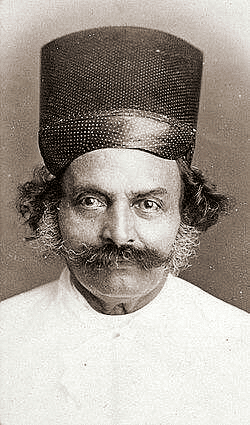
- Davar kickstarted India's industrial revolution by establishing the first steam-powered textile mill in Bombay in 1854.
- The Bombay Spinning and Weaving Company, with a capital of Rs. 5 lakh, consistently paid a 10 percent dividend for six consecutive years.
- His initiative ensured the safety of industrial capital in India and inspired others like the woods and the Tatas to invest in industries.
2. Sir Jamset Nusserwanji Tata — The Father of India's Industrial Revolution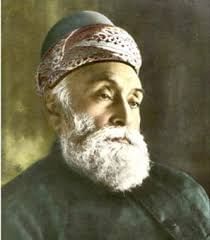
- Sir Jamset Nusserwanji Tata played a pivotal role in India's industrial growth.
- He made significant contributions to various industries, laying the foundation for India's industrial advancements.
- Tata was the pioneering Indian who grasped the importance of the industrial revolution.
- He established pension funds and accident compensation at his Swadeshi textile mill.
- His vision for India's advancement revolved around steel, hydroelectric power, and technical education.
- Tata's influence led to the creation of the Indian Institute of Science (formerly known as the Tata Institute) in Bangalore.
- At the age of 60 in 1900, he founded the Jamshedpur Steelworks after acquiring knowledge of steel-making techniques in Europe.
3. V.O. Chidambaram Pillai - The Steamships That Cried Freedom
- Pillai, a nationalist, ventured into business not only for profit but also to make a statement. His Swadeshi Steam Navigation Company Ltd. challenged the British shipping monopoly in coastal trade with Ceylon.
- Known as VOC, he was a radical Congressman who faced arrest in March 1908 on charges of sedition but was eventually released in 1912.
- Pillai inspired a new wave of conservative southerners to enter the business world.
4. Rai Bahadur Mohan Singh Oberoi - The Pioneer Hotelier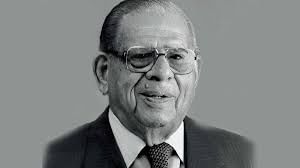
- In 1934, Oberoi displayed remarkable entrepreneurial spirit by mortgaging his wife's jewels to acquire his British partner's stake in Clarke's Hotel, Shimla.
- By investing when the British were pulling out, Oberoi became the first Indian to lead a hotel chain.
- By 1965, he established India's first five-star international hotel in Delhi, marking the beginning of the Oberoi Group's global expansion with 34 hotels across seven countries.
5. Henning Hock Larsen - The Persevering Dane
- Henning Hock Larsen was a Danish entrepreneur who made India his home. Despite his origins, Larsen stayed in India and contributed significantly to the business landscape, showcasing determination and cultural integration.
- Henning Hock Larsen, an enduring figure in Indian business history, alongside his partner Soren K. Toubro, defied the norm by staying in India instead of returning to Europe. Their venture, established in 1938 to construct a cement plant, evolved into India's leading engineering powerhouse. Larsen's foresight and commitment to local manufacturing, now valued at Rs. 5,400 crores, catalyzed a significant engineering revolution in India. His contributions span diverse sectors from nuclear facilities to essential infrastructure, leaving an indelible mark on the country.
6. Dr. Verghese Kurien—Empowering the Dairy Industry
Dr. Verghese Kurien, renowned as the architect of Operation Flood, revolutionized India's dairy landscape, propelling it to the forefront of global milk production. His emphasis on empowering the dairy producers, numbering over 10 million families, reshaped the economic dynamics of the industry. The Kaira District Cooperative Milk Producers' Union, popularly known as Amul, emerged as a formidable force, outperforming multinational rivals. This transformation empowered humble farmers and herders, illustrating one of the world's most successful dairy enterprises.
- Dr. Kurien initiated Operation Flood, the world's largest dairy development program.
- Under his leadership, India became the top global milk producer.
- He empowered 10 million families economically through this program.
- The Kaira District Cooperative Milk Producers' Union, known as Amul, emerged as a formidable competitor against multinational corporations.
- Various stakeholders including farmers and cowherds benefited from this successful dairy operation.
7. Karsanbhai Khodidas Patel - The Power Of The Grassroots
- Karsanbhai Khodidas Patel, with no marketing or management background, created Nirma, an Indian brand that competed with multinational giants.
- Starting from a small shed in his backyard in 1969, Nirma's affordable detergent disrupted established players like Lever.
- Today, Nirma is valued at Rs. 2,440 crore, showcasing Patel's entrepreneurial spirit and success.
- Patel's story inspired many aspiring entrepreneurs to challenge corporate giants.
8. Aditya Vikram -Y-Birla - The First Mogul of Globalization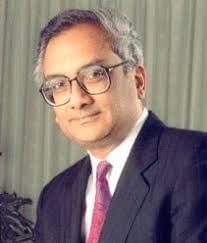
- Aditya Vikram -Y-Birla is recognized as a pioneer in global business expansion.
- He ventured into globalization before many others, establishing a strong presence in various sectors.
- His strategic vision and leadership skills propelled him to great success on the global stage.
- Birla's achievements serve as a testament to the possibilities of entrepreneurial endeavors on a global scale.
- Aditya Vikram Birla, an MIT graduate, played a pivotal role in expanding his grandfather's empire.
- Instead of navigating the bureaucratic hurdles in India, Birla ventured internationally.
- He established a textile mill in Thailand and later the world's largest palm oil refinery in Malaysia.
- By the time of his passing in 1995, his group had operations in 17 companies spread across 14 countries.
9. Dhirubhai Ambani - The Saga Of The New India
- Dhirubhai Ambani, hailing from a humble background, transformed Reliance into a colossal entity in India.
- Starting from modest beginnings in Aden, he adeptly navigated the business landscape, leveraging opportunities and circumventing challenges.
- By fostering an equity culture and engaging with small investors, he revolutionized the Indian business scene.
- His adaptability during the era of liberalization solidified Reliance's position as an industry giant.
10. N.R. Narayana Murthy: Tech Innovator

- Narayana Murthy, along with a team of professionals, founded Infosys with minimal capital and a strong set of values.
- His emphasis on hard work, humility, honesty, and innovation set a new standard for success in the tech industry.
- Infosys became renowned not only for its financial success but also as a preferred employer due to its values-driven culture.
|
18 videos|55 docs|26 tests
|
FAQs on Evolution of Entrepreneurship in India - CMAT Mock Test Series - CAT
| 1. What is the significance of the Industrial Policy of 1948 in the evolution of entrepreneurship in India? |  |
| 2. What are the key sources of entrepreneurship in India that have contributed to its evolution over the years? |  |
| 3. How have ten entrepreneurs mentioned in the article impacted corporate India and influenced the entrepreneurship landscape in the country? |  |
| 4. How has entrepreneurship in India evolved over the years, and what are some key factors that have influenced this evolution? |  |
| 5. How has the concept of entrepreneurship in India been shaped by government policies and initiatives, such as the Industrial Policy of 1948? |  |

